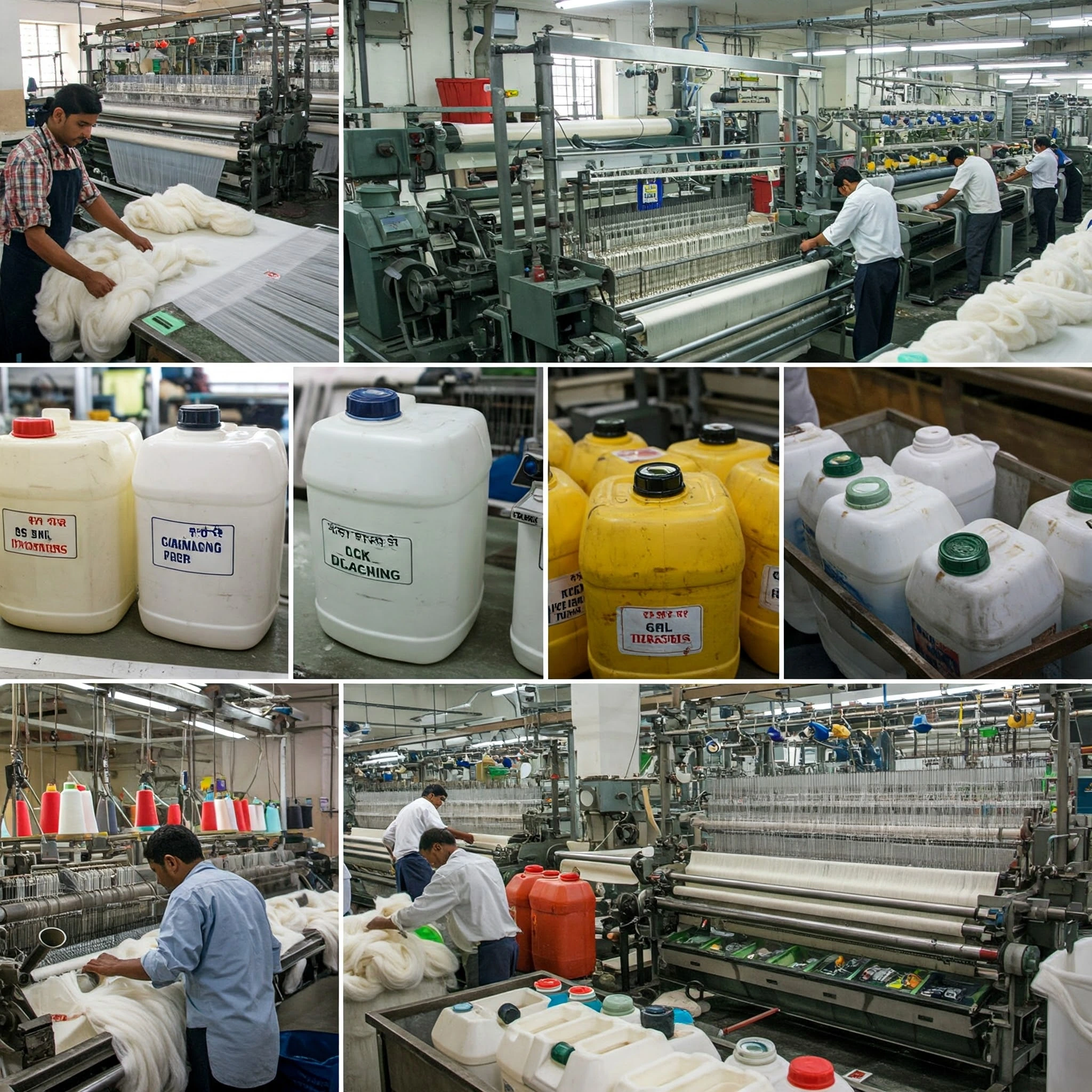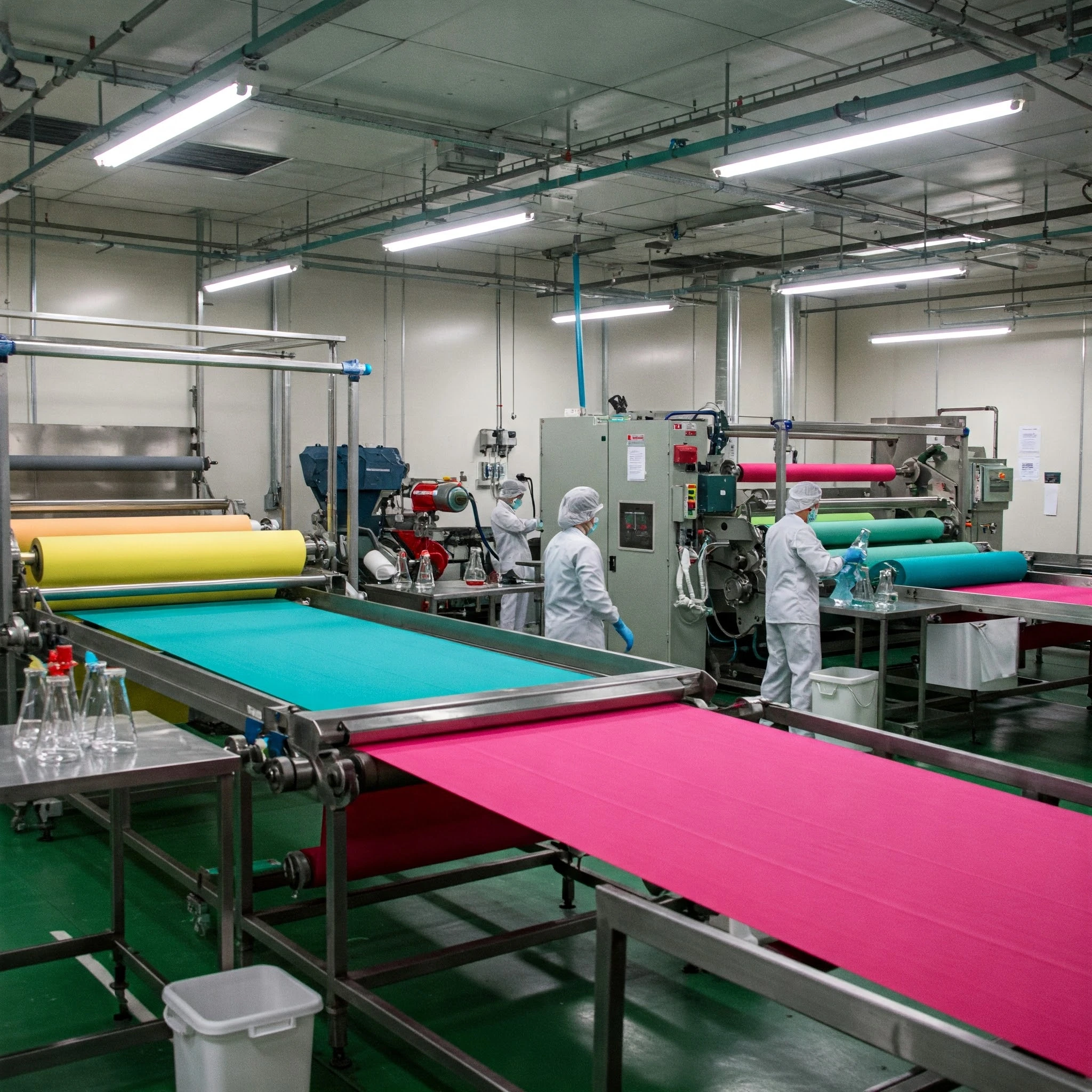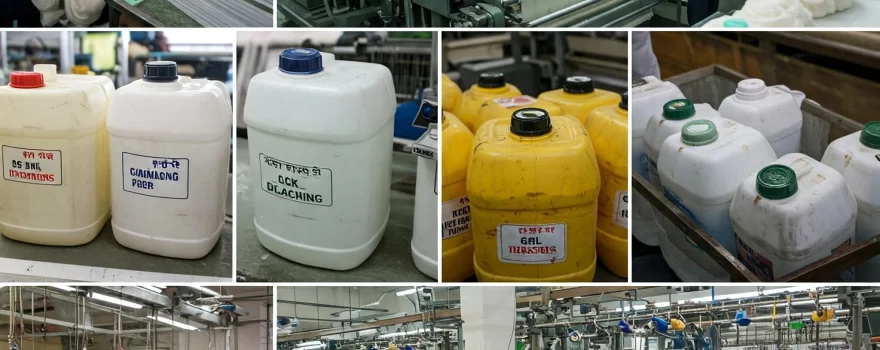
4o
Table of Contents
Textile Chemicals in India: Market Overview
The textile chemicals market in India is of significant economic importance, serving as a fundamental component of the country’s manufacturing strength. It supports a vast network of textile production. Consequently, textile chemicals buyers in India prioritize securing reliable suppliers. These suppliers must consistently provide high-grade chemicals. The quality of these chemicals directly influences the final textile product. Deficiencies in chemical quality can lead to detrimental outcomes. These include diminished product integrity and damaged market reputation. Therefore, the search for reputable suppliers is of critical importance when you buy textile chemicals in India.
Demand Drivers: Textile Chemicals India
| Key Factor | Details | Impact on Chemical Demand |
| The Textile Industry is Booming | Cities are expanding, and incomes are rising. | Increased demand for textile chemicals. |
| Higher demand for clothes and fabrics. | More production leads to more need for chemicals. | |
| People Want More Clothes & Fabrics | Consumers seek variety in apparel and home textiles. | Greater demand for dyes and finishing chemicals. |
| Technology is Advancing | New types of fabrics are being introduced. | Specialized chemicals are required. |
| Innovations drive the need for advanced solutions. | Increased demand for high-tech textile chemicals. | |
| Sustainability Matters | Environmental regulations are becoming stricter. | Companies must adopt eco-friendly chemicals. |
| Government Support | Programs like TUFS and SITP promote industry growth. | Expansion results in higher chemical consumption. |
| Companies are Investing | Businesses are expanding and forming partnerships. | Greater need for textile processing chemicals. |
| Exports are Strong | India exports a large volume of textiles. | Global demand fuels higher chemical use. |
| Technical Textiles are Growing | Rising demand for medical and industrial fabrics. | Increased need for specialized treatment chemicals. |
| Quality and Looks are Key | Customers prefer durable and aesthetically superior textiles. | Chemicals enhance quality, durability, and appearance. |
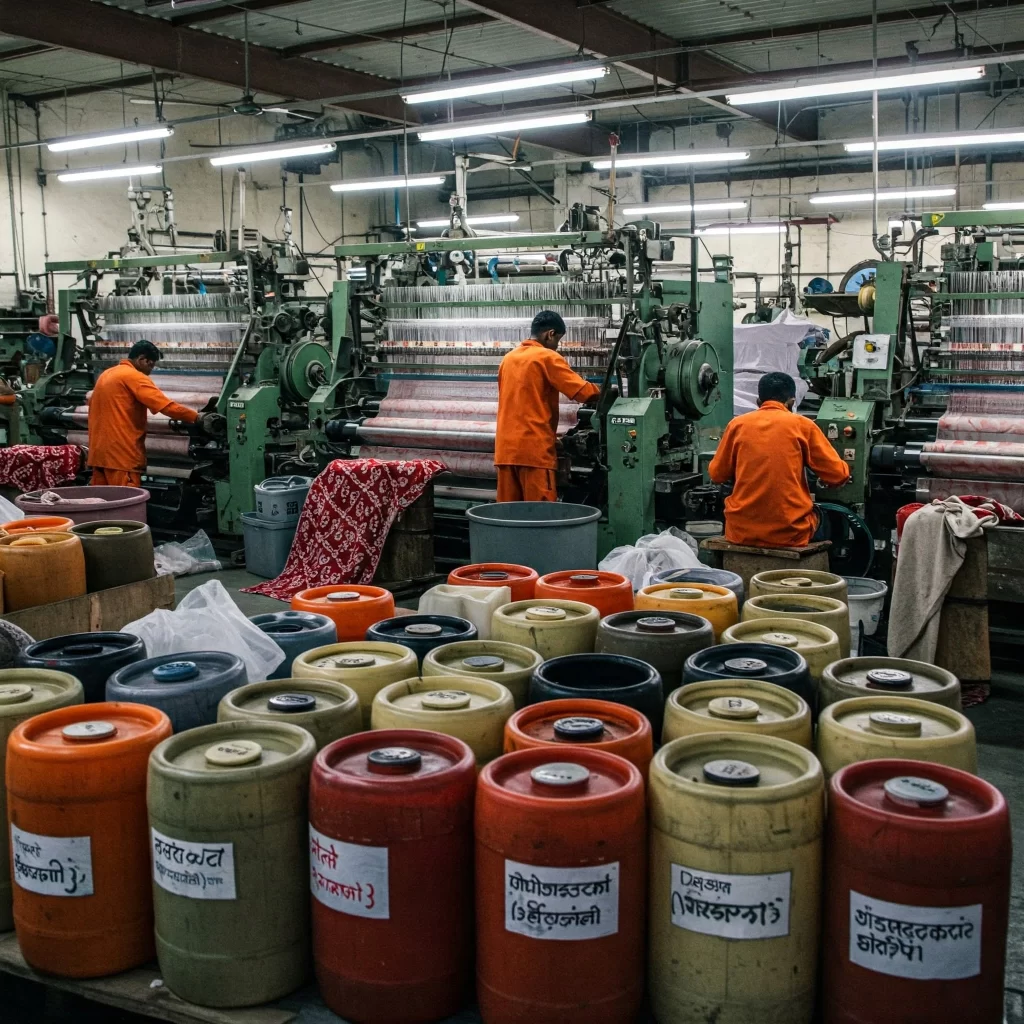
Textile Chemicals: India Dyeing & Finishing
The Indian textile industry utilizes a range of chemicals to achieve desired fabric qualities. Here’s a breakdown by process:
| Process | Category | Function/Details |
| Dyeing | Dyes | Acid, reactive, sulfur, vat (fiber-specific). |
| Wetting/Penetrating Agents | Enhance dye penetration. | |
| Leveling Agents | Ensure uniform color. | |
| Sequestering Agents | Counteract hard water effects. | |
| Dye Fixing Agents | Improve color fastness. | |
| pH Adjusters | Control acidity/alkalinity. | |
| Reducing/Oxidizing Agents | Modify dye/fabric properties. | |
| Printing | Pigments | Provide color and durability. |
| Binders | Adhere pigments to fabric. | |
| Thickeners | Control printing paste viscosity. | |
| Wetting Agents | Promote paste penetration. | |
| Other Auxiliaries | Acids, alkalies, solvents, dispersing agents. | |
| Finishing | Softeners | Enhance fabric feel. |
| Anti-Creasing Agents | Reduce wrinkles. | |
| Water/Stain Repellents | Provide protective barriers. | |
| Flame Retardants | Reduce flammability. | |
| Antistatic Agents | Reduce static cling. | |
| Enzymatic Bio Polishing Agents | Fabric finishing. | |
| Other Auxiliaries | Wax, polyurethane finishing agents. | |
| Pre-treatment | Desizing Agents | Remove sizing materials. |
| Scouring Agents | Clean fabric. | |
| Bleaching Agents | Whiten fabric. | |
| Mercerizing Agents | Enhance cotton strength/luster. |
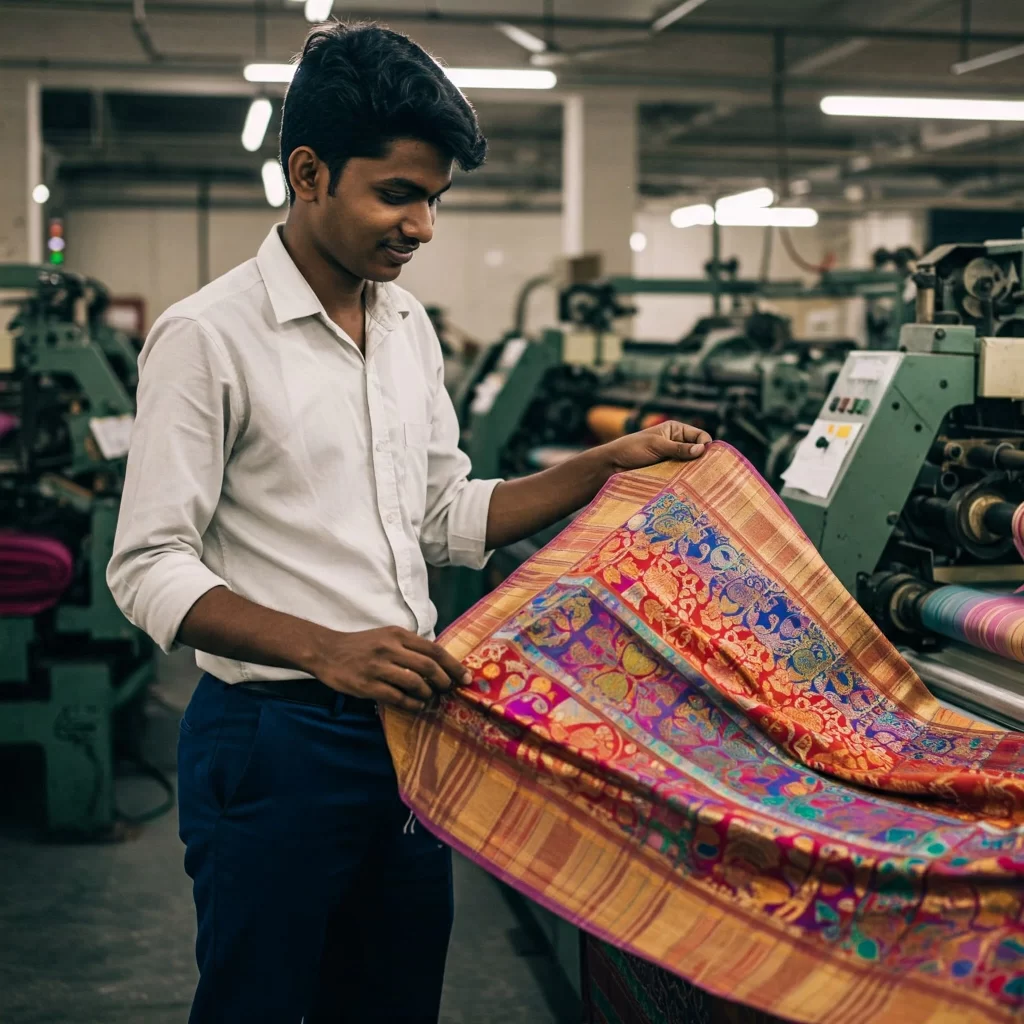
Textile Chemicals Buyers in India
Finding reliable textile chemical suppliers can be a real puzzle. But, don’t worry, I’ve got you covered. Let’s break down where textile chemicals buyers in India can source top-notch chemicals:
Domestic Manufacturers:
Directly purchasing from Indian manufacturers can be advantageous for textile chemicals buyers in India. You get to build a relationship. Plus, you can often negotiate better pricing. Look for companies with strong reputations and certifications.
Distributors:
Distributors act as intermediaries. They often carry a broad range of products from various manufacturers. This can be useful if you require a diverse range of chemicals. They are capable of offering logistical assistance.
Online Platforms:
E-commerce platforms have become increasingly popular. They offer convenience and a wide selection. However, exercise caution. Confirm the seller’s qualifications. Review feedback and ratings.
Industry Trade Shows:
Trade shows offer a valuable chance to connect with suppliers directly. You can review product samples and have discussions regarding your specific needs. It is also an excellent networking opportunity.
Specialized Chemical Suppliers:
Some companies specialize in specific chemical types. If you need a very specific product, look for these specialized suppliers. They often have greater expertise.
Indian Textile Chemical Regulations and Quality Standards
When sourcing textile chemicals in India, navigating the regulatory landscape is essential. Here’s a breakdown of key standards and recent developments:
Bureau of Indian Standards (BIS):
BIS establishes national quality benchmarks. Look for the ISI mark, indicating compliance with Indian standards.
Medical Textiles Quality Control Order (QCO):
The Ministry of Textiles has implemented a QCO for medical textiles.
This mandates strict quality standards for products like sanitary napkins and baby diapers.
Manufacturers must obtain a BIS license 1 to comply. This ensures consumer safety.
REACH Compliance:
While a European Union regulation, REACH impacts global trade. Many Indian exporters adhere to it.
This demonstrates a commitment to safety and environmental responsibility.
Eco-Certifications:
Seek certifications indicating minimal environmental impact. Examples:
GOTS (Global Organic Textile Standard): Certifies organic textiles and chemicals.
OEKO-TEX Standard 100: Tests for harmful substances.
Additional Considerations:
Request Material Safety Data Sheets (MSDS) for chemical handling and safety.
Confirm that suppliers comply with local environmental laws.
India’s Top Textile Chemical Suppliers
Identifying trustworthy textile chemical manufacturers and suppliers in India is vital. You need partners who can guarantee quality and reliability in their offerings. So, let’s explore some of the key players in the Indian textile chemical market:
| Supplier type | Key Details |
| Domestic Manufacturers | Indian firms offer diverse textile chemicals. Prioritize those with innovation and strong customer support. ISO certifications ensure quality. |
| International Brands | Global chemical companies provide advanced technology and rigorous quality control for reliable products. |
| Specialized Suppliers | Niche suppliers focus on specific chemicals like dyes or finishes, offering custom solutions. |
| Distributor Networks | Large networks provide access to multiple brands, handle logistics, and consolidate bulk orders. |
| Online Platforms | E-commerce offers convenience but requires due diligence. Verify seller credentials, reviews, and market history. Prefer long-established companies. |
How to Choose the Right Textile Chemicals for Your Business
Selecting the correct textile chemicals is crucial for your business’s success. It’s more than just buying a product; it’s about finding a partner. Here’s a practical approach:
Define Your Specific Needs:
Results: Specify desired outcomes: strength, colorfastness, fire resistance, softness.
Industry: Apparel, technical, or home textiles? Each has unique chemical demands.
Process: Which chemicals are needed for dyeing, finishing, or printing?
Fiber: Ensure compatibility with cotton, polyester, wool, etc.
Evaluate Potential Suppliers:
Quality: Look for ISO, OEKO-TEX certifications and rigorous testing.
Experience: Choose suppliers with a proven track record.
Sustainability: Prioritize eco-friendly options.
Value: Balance cost with quality.
Support: Select responsive suppliers.
Verification: Confirm licenses and compliance.
Samples: Request verifiable samples and testing reports.
Key Chemical Considerations:
Dyes: Ensure colorfastness and fiber compatibility.
Finishing: Enhance fabric properties (softness, water resistance).
Auxiliaries: Use leveling, defoaming, and fixing agents for consistency.
Safety: Adhere to all regulations.
Testing: Verify safety and performance.
By adhering to these steps, you will be able to get the best chemicals for your textile business.
Textile Chemical Prices: India
Let’s talk about the money side of things. How do textile chemicals buyers in India make sense of textile chemical pricing? It’s not a straightforward equation. Several factors come into play.
Raw Material Price Volatility
Fluctuations in synthetic fiber and dye prices impact production costs.
Price instability creates uncertainty for manufacturers.
Market Demand and Supply Dynamics
Rising disposable incomes and apparel demand drive chemical consumption.
Increased demand can inflate prices, especially if supply is constrained.
Growth in technical textiles (e.g., automotive industry) adds pressure on chemical pricing.
Sustainability and Regulatory Costs
The push for eco-friendly textile chemicals raises production costs.
Compliance with global environmental regulations (e.g., REACH) increases operational expenses.
Technological Advancements and R&D
Companies investing in new formulations and advanced processes face higher costs.
Specialized chemicals (e.g., innovative dyes, advanced color libraries) come at a premium.
Regional Market Dynamics
West India dominates textile manufacturing, influencing pricing trends.
Government subsidies and market competition (300–500 players) shape pricing strategies.
Import/Export and Geopolitical Factors
Geopolitical tensions can disrupt supply chains and increase raw material costs.
Import restrictions may further drive up prices.
Note: While these factors highlight key pricing trends, a detailed cost analysis requires specific data on raw material expenses, production costs, and supplier pricing strategies.
The Rise of Eco-Friendly and Sustainable Textile Chemicals
Driven by environmental concerns and consumer demand, the textile industry is rapidly adopting sustainable practices, focusing on materials, processes, and chemicals that minimize harm and maximize efficiency. This shift is important for textile chemicals buyers in India to understand.
Shift Towards Sustainable Materials:
Biomaterials: Fabrics from pineapple leaves (Piñatex), orange peels, algae, and mushroom mycelium.
Alternative Fibers: Organic cotton, hemp, bamboo, and recycled materials.
Innovative Materials: Mushroom leather, seaweed-based fabrics, recycled polyester.
Recycled Fibers: Transforming textile waste into new fibers.
Biomaterials: Fabrics from pineapple leaves (Piñatex), orange peels, algae, and mushroom mycelium.
Eco-Friendly Manufacturing Processes:
Renewable Energy: Decreasing carbon emissions.
Waterless Dyeing: Supercritical CO2 dyeing eliminates water use.
Enzymes & Green Chemistry: Replacing harsh chemicals with enzymes.
Closed-Loop Systems: Recycling water and chemicals to minimize waste.
Digital Printing: Reduces water and chemical consumption.
Renewable Energy: Decreasing carbon emissions.
Sustainable Textile Chemicals:
Biodegradable Chemicals: Bio-based dyes and finishing agents.
Low-Impact Dyes: Cleaner production through better chemical management.
Eliminating Hazardous Substances: Removing chlorine bleach, azo dyes, and heavy metals.
Key Trends and Drivers:
Transparency & Traceability: Increasing focus on product origins.
Consumer Demand: Driving the adoption of eco-friendly products.
Environmental Concerns: Climate change, resource depletion, and pollution.
Innovation: Enabling sustainable materials and processes.
Circular Economy: Reusing and recycling materials.
Best Textile Chemicals: Your Guide
To summarize, textile chemicals buyers in India have acquired the essential tools to navigate the Indian textile chemical market. It’s about making a smart choice.
Quality matters. Preserve the integrity of your products without making concessions. Reliable chemicals lead to superior textiles. And that’s what builds a strong brand.
Price is a factor, of course. But consider the long game. A modestly higher initial expenditure on quality can protect you from incurring costly problems later.
Compliance is crucial; it is important to stay aware of the applicable regulations and certifications. It protects you and your customers.
Don’t be afraid to ask questions. Demand transparency from your suppliers. They should be partners, not just vendors.
Think about sustainability. The future of textiles is green. Choose chemicals that align with eco-friendly practices.
In the end, it’s your business. Make informed decisions. Choose quality, value, and responsibility.
